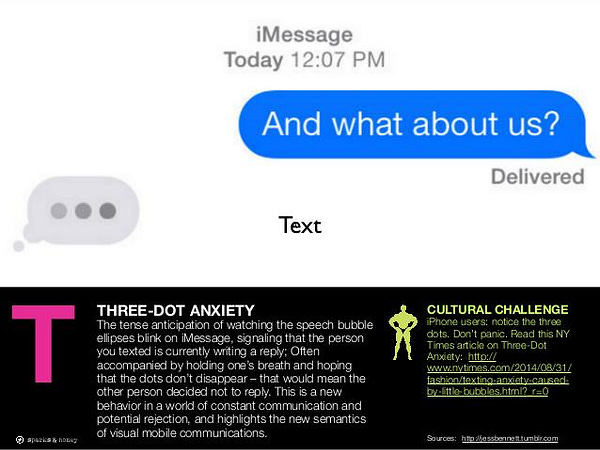So many anxieties
Anxieties made worse by social media and coping strategies courtesy of social media, plus an in-depth look at one of the internet's oldest anxieties
This week, anxieties exacerbated by technology and coping strategies are all over the news. And I’m trying something new—an in-depth look at one internet emotion.
An anxious world
According to a 2022 report by the World Health Organization, anxiety has surged by 25 percent since the start of the COVID pandemic. And we’ve got so many variations, almost all in the news this week.
Democracy Anxiety Disorder, was the topic of an op-ed by psychoanalyst Kerry Malawista in The Baltimore Sun. Coined by a patient, Democracy Anxiety Disorder (DAD) is a uniquely American condition prompted by recent Supreme Court decisions, the January 6 Insurrection hearings, and the overall threat to the electoral process.
Sexual anxiety has already increased dramatically post-Roe. People are seeking support from mental health providers as they grapple with reproductive health decisions.
Recession anxiety is another variation of emotional angst. Along with it, inflation anxiety, is also on the rise according to the American Psychiatric Association. Now one (me, for instance) could argue that the entire economy is made of feelings. Recessions are intimately bound to “consumer confidence” just as the stock market is tied to investors’ deepest hopes and fears.
Climate anxiety is so widespread among young people, that experts fear it will result in a kind of learned helplessness. Environmental psychologist Thomas Doherty introduced the idea of climate change hopelessness at a recent Aspen Ideas Festival.
Anxiety runs in families, and is more likely to be passed from mother to daughter. Some experts suggest that doctors start screening for anxiety in children as they do for many other physical and mental health conditions.
None of these new variations of anxiety are directly caused by technology, but social media can certainly super-charge the spread of negative emotions.
Online ways to cope
Social media can make anxiety worse, but it can also help us to deal with it. TikTok has turned out to be a place where it’s okay to be vulnerable about difficult feelings. Witness all the videos sharing the effects of anxiety. Not only does it feel acceptable to be anxious but videos like the one below activate our sense of compassion.
 Tiktok failed to load.
Tiktok failed to load.Enable 3rd party cookies or use another browser
TikTok is also where you can find potential antidotes to anxiety, like how ice cubes can halt a panic attack. Psychologist Julie Smith listed 5 five “hacks” for icing your anxiety including “ice diving,” a not-for-the-faint-of-heart trick where you dunk your face in a bowl of ice water. This is part of a bigger trend called vagus nerve icing (a real technique therapists use) that’s all over TikTok.
Of course, if you want to dial back your social media experience, there are a lot of options. For instance, Twitter now lets users leave a conversation thread which can reduce anxiety along with other strategies like muting keywords or blocking accounts.
Maybe you can find calm in virtual museums too. Viewing art online can lower anxiety in a way that’s comparable to nature experiences and visits to physical art galleries, according to a study recently published in Frontiers in Psychology.
Finally, texting friends just to check in has more of an impact than we realize. New research, highlighted in this New York Times piece, shows that even a brief text or email can have a big impact on subjective wellbeing. While you might worry that an unexpected check-in wouldn’t be welcome, the more surprising check-ins can be the most meaningful. Feeling more connected improves our overall mental and physical health.
Friday Feeling > Three-dot anxiety
🔑 DEFINITION
The tense anticipation of watching the speech bubble ellipses blink on iMessage, signaling that the person you texted is currently writing a reply.
See also: Read receipt distress, email apnea, FOMO, awkward silence
📜 A BRIEF HISTORY
Circa 2014, the concept surfaced in a variety of news outlets, described as “the tyranny of the text bubble,” “the most awkward part of online chat” or “a certain kind of chat app hell”. In the 2010s, those three dots were associated with texting, especially on iPhones. Now you might think of the “someone is typing” notice on Slack instead.
The typing indicator feature has its roots in the late 1990s. IBM filed a patent in 1997 for “desirable chat feedback.” Microsoft implemented a typing awareness indicator in Microsoft Messenger around the same time. Blackberry (remember?) rolled out the feature in 2005 around the same time as Apple introduced those three dots.
Not all typing awareness indicators are the same though. Early days, Google experimented with real-time typing that would reveal the message as it is typed. Slack only lets you know if someone actually types (not just clicks in the box). On Facebook Messenger, the indicator crops up as soon as a character is entered and disappears in 5-10 seconds if nothing else is entered. Apple’s iMessage indicates typing as soon as you click in the box and those dots linger for a full 60 seconds (seems like a million years) if nothing else is typed.
The idea behind the typing awareness indicator was to make conversations online easier. The reality is more emotionally charged.
💬 EXPRESSION
The typing awareness indicator is one of many adaptations that introduce nonverbal communication into the cybersphere. To substitute for facial expressions, we type emoticons and emoji. For tone and inflection, we make novel use of punctuation. Those three dots are a way to pace a written conversation. Like all of these new nonverbals, it can introduce ambiguity and with it, anxiety.
The dots can simply mean “Hold on, I’m typing.” It can also signify “Hey, it’s my turn to speak” or “I’m responding, but this might take a minute because I have a lot to say.” All relatively neutral.
Some conversation gambits prime people for the worst.
“Can we talk?” Almost never a promising starter.
“Are you okay?” Meaning that the person on the other end is thinking, no you’re not okay.
“Are we still on for coffee?” Because what if they are no longer interested or were just trying to get rid of you in the first place.
“I’m here. Where are you?” In this case, maybe they forgot and you’re already there.
“I love you.” Eternally anguished but especially in chat where you can go to they don’t love me to they are breaking up with me to they never loved me in mere minutes.
Other nerve-wracking scenarios include: an initially sally, a conversation after a hiatus, in the middle of sexting, and after telling a joke.
The meaning also changes depending on how much time elapsed. A long pause could convey uncertainty. Or that you’re carefully weighing your words. Or that you’ve simply become distracted. With a long pause followed by a one-word response, you know they are holding back.
Then, there’s the anxiety of typing too slowly or too quickly. Too slowly, and you begin to sense the person on the other end muttering impatiently. Too quickly, and it will look like you had a response already prepared (hopefully you did a little pretend-typing before cutting and pasting a response from notes).
💗 EXPERIENCE
Three-dot anxiety is mostly experienced by the message receiver. It starts with a pang of intense curiosity often accompanied by holding one’s breath until an answer appears and an inability to focus attention on anything else. Because we can see that ~something is happening~ it leads us to speculate.
Waiting for the message to appear creates that little blip of anxiety. When you’re waiting for an answer to an important question, it can give you a little pang of anxiety. When you’re in the heat of an argument, it can feel like a ticking time bomb. The more sensitive or emotionally charged the conversation, the higher the impact of the pause.
The longer the pause, the more elevated the heart rate as you prepare for the worst. That ellipses can be the threat of an unwanted emotion—disappointment, usually. Or it prompts feelings of doubt, in yourself or in the relationship with the sender. The possibility of rejection looms.
If the dots pop up and then disappear, feelings change quickly from anticipation to annoyance. Anxiety may turn to worry, resulting in obsessive checking for any further response. For the sender who starts a text and then decides against it, there’s the anxiety over whether the intended receiver saw the typing.
Once the response is received, there’s a quick turn away from anxiety and toward the emotional content of the message.
Post message, it’s time for the next adrenaline rush brought on by a steady stream of digital micro-communications.
🎉 FUN FACT
Three-dot anxiety was officially named by trendspotters Sparks & Honey in 2015. Their 2015 A-Z report is no longer online but this tweet referencing the culture glossary lives on.


🎩 PERSON OF INTEREST
Georgetown linguist Deborah Tannen and author of You Just Don’t Understand studies turn-taking in spoken conversations. Tannen’s research has shown that conversational turn-taking can cause friction. Certain cultures have what she calls a “high-involvement style,” where interruption is valued as a sign of engagement (hello Americans). Others have a “high-considerateness style” where it’s polite to wait your turn. When the styles clash, it’s a problem.
Texting is a bit different. You don’t need the other person to “give you the floor” but it is hard to know when to shift the conversation. That’s where the typing awareness indicator could theoretically prevent anxiety.
❝ QUOTE
"The awareness indicator as implemented on the iPhone is a curious beast – it conveys that something is being done, but it won't say what. It's curiously coy.” Paul Dourish, Professor of Informatics at the University of California, Irvine
💡 BIG PICTURE
Those three dots function as both a source of hope and of a possible letdown. The emotional weight we tend to attach to those little tiny ellipses is fleeting though. Of all the tech-induced anxieties, 3-dot anxiety is low in intensity and not always negative.
How much the dots matter depends on your relationship with the person on the other side of the chat and on the sensitivity of the topic itself. Context matters too. If you’re feeling stressed already, it’s likely to affect your susceptibility.
One way around this special micro-anxiety is to turn off the typing awareness indicator in the app (although finding the off-switch will likely be a struggle). A simpler path might be to reframe those dots in terms of turn-taking to ease some of the pressure.
🤔 LEARN MORE
Read the story behind the invention of the typing awareness indicator as told by Jerry Cuomo, one of the principals on US Patent 5,990,887
Here’s The New Republic piece by Ben Crair that started a flurry of follow-ups
Jessica Bennet takes a deeper dive into the bubbles that carry a lot of weight in this New York Times article
The latest cover for Judy Blume’s Are You There God? It’s Me, Margaret is the perfect crystallization of three-dot anxiety
Apparently, there’s a chapter about typing awareness indicators in the Boredom Studies Reader
✨✨✨✨✨
That’s all the feels for this week!
xoxo
Pamela 💗




